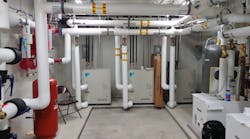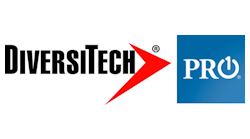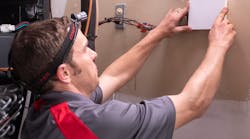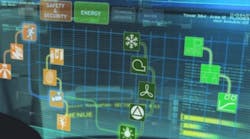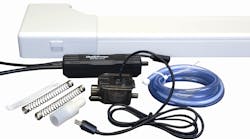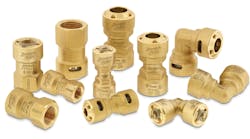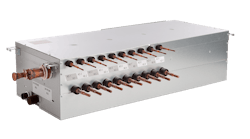By Terry Hoffmann
Environmental sustainability is broadly defined as commercial building practices that address climate change, that preserve resource and energy efficiency, and that use eco-friendly products and processes that address green building programs and social responsibility — including reporting initiatives.
Sustainability is not simply a management directive. It’s an issue of substance for everyone within an organization. However, not all of your employees or many customers know what it’s all about. Therefore, your first step to achieving success in sustainability is to think of it as you would customer service or public relations. You need to be able to describe it to key constituents and those whose support you’re trying to gain.
First, understand the value that you or your company brings to the equation. Then, you must be able to articulate it. And of course, everyone in the organization must be aligned and presenting the same message.
Since we’re all in the building systems business, let’s examine how sustainability relates to technology. Technology provides a means to achieve the following attributes of an intelligent building systems solution: reliability; compatibility; mobility; connectivity; scalability; security; interoperability; efficiency; flexibility; sustainability.
Technology enables us to formulate a sustainable solution, but it’s not the solution itself. This is important to keep in mind when pondering your contribution to sustainability.
These are good times to be in the sustainable solutions business, because green messages are everywhere — in the media, in our schools and universities, in businesses, in government and non-profit entities — and green messages become more prevalent every day.
Decision-makers are often willing to invest in products and services that help their organizations achieve sustainability objectives. They may need to satisfy shareholders, environmental groups, or government agencies. Or they may simply believe it’s the right thing to do. For any or all of these reasons, sustainable solutions are viewed differently than traditional solutions that promise a payback on their investment at a fixed point in time. Social responsibility now competes with financial concerns for top management’s attention on more construction projects – especially high-profile facilities.
This isn’t to say that customers will write a blank check in return for a sustainable solution. In fact, you’ll have a greater chance of thriving in this environment if your offering is no more costly than a traditional offering. While there are tremendous opportunities for premium products, the most basic level of sustainable construction does not differ greatly from other solutions.
Sustainability Pays Big Dividends
Building owners are financially motivated to incorporate sustainability into new construction and renovation projects. High-performance green buildings eliminate waste, keep utility bills manageable, and reduce operations and maintenance costs for the life of the facility. Green buildings also help increase employee productivity, according to many studies.
Facilities that have obtained LEED certification (Leadership in Energy and Environmental Design) can claim these average savings over traditional buildings, according to The New Buildings Institute and the U.S. Green Building Council:
- energy savings — 20 to 50%
- carbon savings — 35%
- water use savings — 20 to 50%
- waste cost savings —50 to 90%.
Get to Know Your Customers
How can you thrive in this new world of sustainability? Assuming everyone in your organization understands the sustainability value proposition and can clearly articulate it, you must also know your customer better than they know themselves. Spend the time to ascertain the customer’s wants, needs, and desires so you can accurately assess what they need vs. what they say they need. Gather information from management, users and other stakeholders. Host a roundtable discussion, either inperson or through a collaborative online forum. This will help establish a team atmosphere right from the start.
Implementation Presents New Challenges
New technology can present new challenges in the design, construction, and commissioning phases. To avoid trouble, do your homework thoroughly. Carefully research vendors with experience in supplying cutting edge sustainable products. Reach out to consultants who specialize in sustainability, and identify engineers who have designed similar projects. Be confident that whoever installs the new equipment clearly understands the nuances of the technology.
Communicate Importance of System Commissioning
No good specification is complete without identifying how the system will be commissioned. This is critical with sustainability projects because, without a good commissioning process, it’s difficult to ensure that equipment is delivering maximum efficiency. This differs from an automated building control system, for example, because hot and cold complaints will signal problems rather quickly. Quite often, there will not be similar triggers in a high technology system that has only recently been introduced. During the design phase, the project team should specify whether commissioning will occur system by system, or if a commissioning agent should be employed to take responsibility for everything.
With newer technologies, it’s important to take a “perpetual commissioning” approach. At regular intervals, make sure the equipment is functioning as designed. Never be satisfied that it merely works.
Participate in Green Projects
If you want to be a serious player in the sustainability business, you can acquire knowledge by participating in green projects whenever you can. This goes beyond bidding on contracts. Participate in sustainable projects by choice, no matter how small, perhaps even on a volunteer basis for a local community organization. The goal is to be involved in projects that will enhance your sustainability expertise and make you part of the sustainability community.
Explore city, county or state organizations that promote sustainable objectives such as carbon neutrality. You’ll gain valuable knowledge, and be positioned as a potential contractor for sustainable construction projects when they arise. You might even consider forming a consortium of local professionals and pursue sustainability projects as a team of experts in this emerging field.
Several national and state organizations offer green certifications. The most prestigious of these is a LEED Accredited Professional (AP), but take time to explore the certifications available from other associations.
A World of Resources
Many industry organizations are now dedicated to disseminating knowledge and helping their members succeed in the sustainability marketplace. Among the major ones are:
- Association of Energy Engineers (AEE)
- American Society of Heating, Refrigerating and Air-Conditioning Engineers (ASHRAE)
- Continental Automated Buildings Association (CABA)
- U.S. Green Building Council (USGBC)
- U.S. Department of Energy (DOE)
Consultants are a great resource, too. As mentioned earlier, some consultants specialize in sustainability solutions and can help you in many ways. Traditional mechanical and electrical consultants also are gaining more exposure to sustainability issues, and are another resource as you develop your expertise.
When you achieve success, don’t keep it a secret. Establish or invigorate media relationships to promote your sustainability involvement. Remember that every project is a showcase. If you don’t have an in-house public relations capability, consider engaging a PR firm to spread the word locally or beyond. And make sure every employee in your organization is aware of the success and talks it up outside the office. Word-of-out-mouth advertising can lead to new opportunities in unforeseen ways.
Last, but not least, don’t forget the power of the Internet. Go beyond web sites and blogs to the emerging social networking sites. They can lead to new opportunities if your approach is informational rather than sales-driven.
As noted at the outset, sustainability is here to stay. Use these ideas as a guide and you’ll be well on your way to thriving in the sustainability market.
Terry Hoffmann is sales and marketing director of Building Automation Systems for Johnson Controls, Inc. He can be reached by e-mail at [email protected], or by phone at 414/524-4698.
Project Demonstrates Sustainable Diversity
Johnson Controls will serve as the general contractor and will solicit bids for all facets of the project, including HVAC mechanical contracting. Dan Maxwell, Johnson Controls project manager, says, “We were originally selected as the controls contractor, but our role kept on growing, until we were asked to serve as the project’s general contractor.”
Maxwell has extensive project management experience, and has relocated to Oregon just to manage this project. A solar photovoltaic system has enough high-tech batteries to run a submarine, allowing Independence Station to be off the electrical power grid for extended periods of time, providing safety and security for residents, business owners and customers. An alternative energy research center will partner with Oregon State University to explore innovative solutions for the future.
